|
|
|
|
 |
 |
|
PDF Downloadable version of the:
Bus & Coach Professional Article April 2006
|
|
 |
|
|
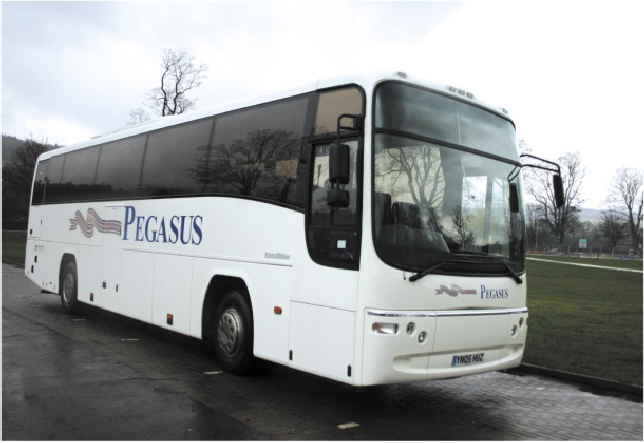 |
 |
 |
|
A sound decision
Perth-based Paragon Travel is pleased with its decision to opt for a Plaxton-bodied Eurorider. Gavin Booth puts the coach through its paces for the latest in our Tried and Tested series.
It was one of these days for which the good old Scottish word ‘dreich’ was invented. One of these grey days when the dawn never quite finishes and seems to merge seamlessly into the dusk.
A day when you’re glad you’re on the way to test a white vehicle, because nothing else would show up in the photographs.
I was on my way to Perth, its position pinpointed by dark grey rain clouds centred over the town that normally rejoices in the description ‘The Fair City’. Perth is of course home for the global headquarters of the Stagecoach Group, and while I wasn’t on my way to see Brian Souter or any of his lieutenants, you usually find some form of Stagecoach connection when you visit local operators. And that was certainly the case with Pegasus Travel, owner of one of the still rare Plaxton-bodied Irisbus EuroRider coaches.
“There’s no badging on the front, though there are discreet EuroRider
badges on the sides and an Iveco badge on the rear”
EuroRiders are not rare; the Beulas-bodied version has been around for a number of years, and nearly two years ago we tested one of these. There were a few niggles, mostly concerning aspects of the body, and we suggested that a facelift might help – something that has been addressed this year. But overall we thought it was a pretty good coach.
So, two years on, how would it be with a Plaxton body? Pegasus director, Duncan Graham, had organised the test for us, and had the coach’s normal driver, Tam Stewart, standing by. It’s always good to have the regular driver on hand, because sometimes you’ll learn things about a vehicle that the boss may be unaware of, things that would never be apparent on a short roadtest. Today, Stewart would only point to a couple of minor niggles about the driver’s instrument display.
The EuroRider was sitting in the Pegasus yard. There was little at the front to tell you that it was in any way different to the hundreds of recent Plaxton coaches you can see throughout the country. There’s no badging on the front, though there are discreet EuroRider badges on the sides and an Iveco badge on the rear; the main giveaways are the Iveco wheel coverings.
The Plaxton Paragon is a competent, attractive coach. It may not have the dramatic looks of some of its continental competitors, but for many of its customers this may be seen as a good thing. It is a nicely-proportioned contemporary coach, and by all accounts Plaxton build quality is back where it should be after problems with previous models.
|
 |
 |
 |
 |
 |
 |
 |
 |
 |
 |
|
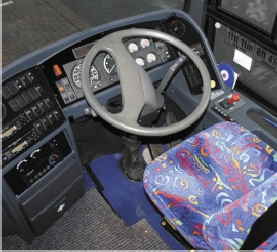 |
|
|
|
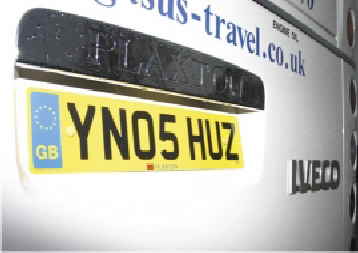 |
|
|
|
Paragon’s EuroRider has a five-speed ZF automatic gearbox.
“The Plaxton Paragon may not have the dramatic looks
of some of its competitors, but for many of its customers
this may be seen as a good thing”
The Pegasus coach is a 49-seater with a sunken toilet, and the seats are finished in an attractive blue moquette, much to the delight of Tam Stewart, an avid Rangers fan. Stewart eases it out of the yard and takes the road in towards the centre of Perth, stopping at a bus stop to hand it over to me. This is his regular coach, and so he handles it with a confident familiarity; watching him, it looks like an easy coach to drive. It is, and copes easily with the stop-start traffic. Well, let me qualify that. It has bags of oomph from a standing start, but stopping it is, well, a bit dramatic.
Now there’s nothing wrong with the braking. Far from it. Stewart had warned me that it didn’t take much effort to stop the EuroRider, and I quickly found out how right he was. The slightest pressure on the brake pedal slowed it impressively, and when you forgot and applied what your heavy-footed tester would regard as medium pressure, it stopped on its nose. The message, for both the accelerator and brake pedals, was apply gently. On a fast dual-carriageway this was ideal, but in stop-start traffic it could strain the right ankle applying just the correct braking pressure. Had I been able to move the driver’s seat back it would have been less of a problem, but there isn’t much fore-and-aft movement possible.
These are minor niggles, and by the end of the test I was braking smoothly to a halt as confidently as Stewart had. His only niggles were about the instrument display. The fuel gauge has a floating needle, which can float with alarming speed towards the empty position after sitting at half-full for ages – and then float back to half-full. While fuel levels were not a problem on the roadtest, Stewart’s other gripe was. The big thick-rimmed steering wheel obscures the top row of warning lights, and the driver can’t, for instance, see if direction indicators are on. Irisbus says that the upgraded Euro 4 models due in autumn 2006 are likely to have a different dashboard layout.
The power from the 310bhp engine, not the most powerful available, was impressive, and there was little noise from the rear-mounted engine, even in the empty coach. The Pegasus coach is fitted with a ZF automatic gearbox, and changes were virtually imperceptible as it climbed through the gears.
““With over 53,000km under its belt,
the EuroRider has never missed a beat”
Duncan Graham Pegasus Travel
|
|
|
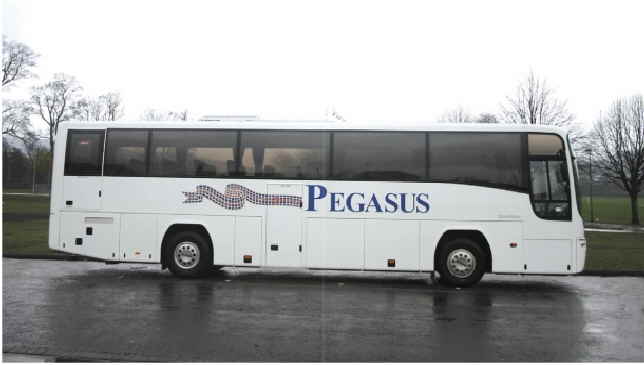 |
|
|
The EuroRider is achieving an average of 9mpg, occasionally pushing 10mpg.
|
|
|
|
 |
|
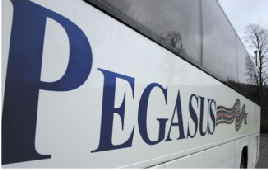 |
|
|
Paragon’s EuroRider has a five-speed ZF automatic gearbox.
“The power from the 310bhp engine was impressive
and there was little noise from the rear-mounted engine,
even in the empty coach”
Like the Beulas-bodied example tested in 2004, the Plaxton was a joy to drive. Tam Stewart moved on to it after a string of Volvo B10Ms, the normal Pegasus big coach choice, and while he was sceptical at first he has quickly warmed to it and would be reluctant to part with it.
Back at the Pegasus garage at Inveralmond for a chat with Duncan Graham. He started with the fledgling Stagecoach company as a driver in 1982, rose to become its operations manager for Scotland and moved to National Express with the Caledonian Express operation. He moved to Scottish Citylink and for a while was involved in the coaching business with Ann Gloag’s brother, Robin. Pegasus Travel emerged from that link and is now run by Duncan Graham and his small team.
The current fleet of 10 vehicles consists of three small Mercedes-Benz coaches, an Autobus Classique and two Plaxton Cheetahs, and seven full-size coaches – two DAFs, four Volvos and the EuroRider. Graham’s ideal fleet size would be around eight coaches, he says, a good size for the resources he has. They are used on private hires as well as work for tour operators, and there are private and regional contracts. He has tendered for supported services, but has no ambitions to try commercial local bus work, recognising that Stagecoach and other private operators dominate the local market.
So why the Irisbus where Volvos were previously favoured? “We bought a new Cheetah in 2003 and nothing in 2004, so we felt we should go looking for something for 2005. We thought about another Cheetah, but when we spoke to Plaxton there wasn’t much available. They asked if we wanted to look at the EuroRider as there were a couple on hand. We did, took one out on a test run, and liked it. What we also liked was the price. It was £180,000, while a Paragon-bodied Volvo B12M would have cost some £25,000 more. That’s a big saving for a small operator and we reckoned we should go for it.
“It has done everything we asked of it and we’ve kept it working hard since we got it in April. We had made a decision earlier to standardise on Mercs for small coaches and Volvos for the big stuff, so the EuroRider was quite a departure for us. In addition it has the ZF automatic box, when everything else we had was manual. We brought it up to Scotland and allocated it to Stewart on a semi-permanent basis.”
Duncan Graham jokes about his drivers adapting to the automatic box. “When they take the EuroRider out they’re always falling out of their seats as they have no gear lever to lean on!”
With over 53,000km under its belt, Graham says that the EuroRider has never missed a beat and driver Tam Stewart independently confirms this. Pegasus hasn’t had much cause to test the after-sales support, but has been impressed by the parts service from Edinburgh Iveco dealer, A&M Phillips. Fuel consumption – an important consideration for all operators in this time of wildly fluctuating pump prices – averages around 9mpg on the EuroRider, occasionally pushing 10mpg, which is not quite on a par with the B10Ms, returning between 9 and 10.5mpg.l
|
|
|
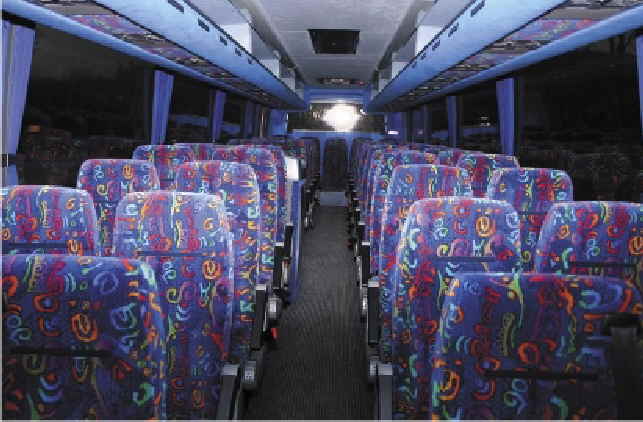 |
|
|
|
“We were a bit cautious at first about where we sent it. We knew that if we sent a Volvo out, it would always come home. With the EuroRider we were a bit unsure, but it has never let us down and we’ve used it on tours, local and longer-distance hires and overseas work. Passengers just see an attractive modern coach with an up-to-date registration plate and they don’t really care what’s underneath it. Tour companies too want a recent coach and we are tapping into tour operators in the United States who, when they learn that we have an 05 coach, want this to be used on all of their work.”
Readers may suspect that the lower selling price of the EuroRider means that they’ll get a coach that is somehow inferior to, say, the equivalent Volvo. On the evidence of my test-drive and Duncan Graham’s enthusiasm, it’s surprising that there aren’t more EuroRiders around. Irisbus has gained a foothold in the UK market with its Daily minibuses and Beulas-bodied EuroRiders. It is keen to increase its share of the UK market and with a complete new Euro 4 range due in autumn 2006 is considering which bus and coach models to sell in the UK. At a reputed €2.5 million (£1.7million) to produce a right-hand drive variant, Irisbus has to weigh the market up carefully. With a 25 per cent market share on mainland Europe but only an 8 per cent UK share, we are clearly in the Irisbus sights.
Until then the EuroRider is well worth considering. It’s available from Plaxton with the Paragon body, from UK Coach & Bus with Beulas body, and from BASE with Marcopolo body. It comes in 310bhp and 352bhp versions, with various gearbox options including the ZF 6S-1600 synchromesh and 5HP 500-series boxes and a Voith automatic. A 12.7m-long version with Beulas body was introduced last year.
|
|
|
|
|
|